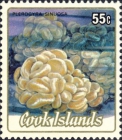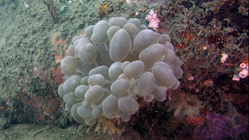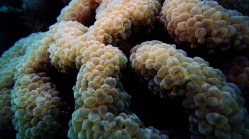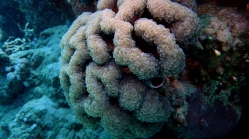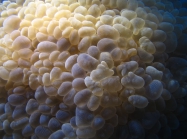WoRMS taxon details
Plerogyra sinuosa (Dana, 1846)
207498 (urn:lsid:marinespecies.org:taxname:207498)
accepted
Species
Euphyllia cultrifera Dana, 1846 · unaccepted > junior subjective synonym
Euphyllia sinuosa Dana, 1846 · unaccepted > superseded combination (basionym)
Plerogyra cultrifera (Dana, 1846) · unaccepted > junior subjective synonym
Plerogyra excavata Milne Edwards & Haime, 1848 · unaccepted > junior subjective synonym
Plerogyra laxa Milne Edwards & Haime, 1848 · unaccepted > junior subjective synonym
marine, fresh, terrestrial
(of Euphyllia sinuosa Dana, 1846) Dana, J.D. (1846-1849). Zoophytes. United States Exploring Expedition during the years 1838-1842. <em>Lea and Blanchard, Philadelphia.</em> 7: 1-740, 61 pls. (1846: 1-120, 709-720; 1848: 121-708, 721-740; 1849: atlas pls. 1-61)., available online at http://www.sil.si.edu/digitalcollections/usexex/navigation/ScientificText/USExEx19_08select.cfm [details] 
Note "East Indies" (Veron, 1986).
From other sources
Type locality "East Indies" (Veron, 1986). [details]
Description This forms sub-massive to massive colonies, usually not exceeding 40 cm across in this region. Series are meandroid and...
Description This forms sub-massive to massive colonies, usually not exceeding 40 cm across in this region. Series are meandroid and large, with some monocentric calices. Series are not joined laterally to adjacent ones. The latter feature distinguishes the genus from Physogyra which is otherwise very similar. Septa are very large (up to 10 mm radius above the wall), separated by up to 5 mm from adjacent septa in the valley, have smooth edges and curve sideways. Valleys are about 15 - 25 mm wide, and there is no columella. When young, single calices or series appear stalked, reaching 5 or 6 cm tall. The adult form is massive. Meandroid valleys are mostly laterally unattached to other valleys, though these meandroid calices fuse with and part from each other at frequent intervals along their length. In many small colonies, series are attached by very broad, flaky coenosteum. However, they remain distinct from the genus Physogyra whose series are more closely united. Living colonies are covered with grape sized vesicles which have a photosynthetic function. At night these retract and tentacles are extended. (Sheppard, 1998 <308>)
Colonies are phaceloid to flabello-meandroid with valleys more or less connected by a light blistery coenosteum. Septa are large, imperforate, smooth-edged, very exsert and widely spaced. Walls are imperforate. Columellae are absent. Polyps are extended only at night. During the day, polyps extend clusters of grey vesicles the size and shape of large grapes, These retract slowly, if at all, when disturbed. Colour: bluish-grey. Abundance: restricted to protected caves or crevices where it grows on vertical faces or under overhangs. Large colonies are sometimes found on flat substrates in partly turbid water. Usually uncommon. (Veron, 1986 <57>)
Unusual coral in which the large polyps extend enlarged, grape-like vesicles (not tentacles) during the day, but these are retracted at night when the tentacles are extended. Although the polyps are large, the colonies are small with a light skeleton which has elaborate, petal-like septa. Colour: vesicles have faint, irregular stripes. Habitat: sheltered reefs. (Richmond, 1997) [details]
Colonies are phaceloid to flabello-meandroid with valleys more or less connected by a light blistery coenosteum. Septa are large, imperforate, smooth-edged, very exsert and widely spaced. Walls are imperforate. Columellae are absent. Polyps are extended only at night. During the day, polyps extend clusters of grey vesicles the size and shape of large grapes, These retract slowly, if at all, when disturbed. Colour: bluish-grey. Abundance: restricted to protected caves or crevices where it grows on vertical faces or under overhangs. Large colonies are sometimes found on flat substrates in partly turbid water. Usually uncommon. (Veron, 1986 <57>)
Unusual coral in which the large polyps extend enlarged, grape-like vesicles (not tentacles) during the day, but these are retracted at night when the tentacles are extended. Although the polyps are large, the colonies are small with a light skeleton which has elaborate, petal-like septa. Colour: vesicles have faint, irregular stripes. Habitat: sheltered reefs. (Richmond, 1997) [details]
Hoeksema, B. W.; Cairns, S. (2024). World List of Scleractinia. Plerogyra sinuosa (Dana, 1846). Accessed through: World Register of Marine Species at: https://www.marinespecies.org/aphia.php?p=taxdetails&id=207498 on 2024-09-24
Date
action
by
![]() The webpage text is licensed under a Creative Commons Attribution 4.0 License
The webpage text is licensed under a Creative Commons Attribution 4.0 License
original description
(of Plerogyra laxa Milne Edwards & Haime, 1848) Milne Edwards, H.; Haime, J. (1848). Recherches sur les polypiers. Mémoire 4. Monographie des Astréides (1). <em>Annales des Sciences Naturelles, Zoologie, Series 3.</em> 10: 209-320, pls. 5-9. [details]
original description (of Euphyllia cultrifera Dana, 1846) Dana, J.D. (1846-1849). Zoophytes. United States Exploring Expedition during the years 1838-1842. <em>Lea and Blanchard, Philadelphia.</em> 7: 1-740, 61 pls. (1846: 1-120, 709-720; 1848: 121-708, 721-740; 1849: atlas pls. 1-61)., available online at http://www.sil.si.edu/digitalcollections/usexex/navigation/ScientificText/USExEx19_08select.cfm [details]
original description (of Euphyllia sinuosa Dana, 1846) Dana, J.D. (1846-1849). Zoophytes. United States Exploring Expedition during the years 1838-1842. <em>Lea and Blanchard, Philadelphia.</em> 7: 1-740, 61 pls. (1846: 1-120, 709-720; 1848: 121-708, 721-740; 1849: atlas pls. 1-61)., available online at http://www.sil.si.edu/digitalcollections/usexex/navigation/ScientificText/USExEx19_08select.cfm [details]
original description (of Plerogyra excavata Milne Edwards & Haime, 1848) Milne Edwards, H.; Haime, J. (1848). Recherches sur les polypiers. Mémoire 4. Monographie des Astréides (1). <em>Annales des Sciences Naturelles, Zoologie, Series 3.</em> 10: 209-320, pls. 5-9. [details]
context source (Hexacorallia) Fautin, Daphne G. (2013). Hexacorallians of the World. (look up in IMIS) [details]
basis of record Veron JEN. (1986). Corals of Australia and the Indo-Pacific. <em>Angus & Robertson Publishers.</em> [details]
additional source Cairns, S.D., B.W. Hoeksema & J. van der Land. (1999). Appendix: List of extant stony corals. <em>Atoll Research Bulletin.</em> 459: 13-46.
page(s): 23 [details]
additional source Cairns, S.D., B.W. Hoeksema & J. van der Land. (2007). as a contribution to UNESCO-IOC Register of Marine Organisms. (look up in IMIS) [details]
additional source Gittenberger. 2003. The wentletrap Epitonium hartogi spec. nov. (Gastropoda: Epitoniidae), associated with bubble coral species, Plerogyra spec. (Scleractinia: Euphylliidae), off Indonesia and Thailand. Zoologische Verhandelingen (Leiden) 345: 139-150
page(s): 139 [details]
additional source Liu, J.Y. [Ruiyu] (ed.). (2008). Checklist of marine biota of China seas. <em>China Science Press.</em> 1267 pp. (look up in IMIS) [details] Available for editors [request]
[request]
additional source Veron JEN. (2000). Corals of the World. Vol. 1–3. <em>Australian Institute of Marine Science and CRR, Queensland, Australia.</em> [details]
additional source Veron JEN. (2002). New species described in Corals of the World. <em>Australian Institute of Marine Science Monograph Series.</em> 11: 1-209.
page(s): 87 [details]
additional source Wells JW. (1961). Notes on Indo-Pacific scleractinian corals. Part 3, A new reef coral from New Caledonia. <em>Pacific Science.</em> 15: 189-191.
page(s): 189 [details]
additional source Scheer G, Pillai CSG. (1974). Report on Scleractinia from the Nicobar Islands. <em>Zoologica, Stuttgart.</em> 42(122): 1-75.
page(s): 10, 62, 75, plate 28 [details]
additional source Yabe H, Sugiyama T, Eguchi M. (1936). Recent reef-building corals from Japan and the South Sea Islands under the Japanese mandate. I. <em>The Science reports of the Tôhoku Imperial University, Sendai, 2nd Series (Geologie).</em> Special Volume 1: 1-66, pls. 1-59.
page(s): 18 [details]
additional source Matthai G. (1928). A Monograph of the Recent meandroid Astraeidae. <em>Catalogue of the Madreporarian Corals in the British Museum (Natural History).</em> 7: 1-288, pls. 1-72. [details] Available for editors [request]
[request]
additional source Pillai CSG, Scheer G (1976) Report on the stony corals from the Maldive Archipelago. Results of the Xarifa Expedition 1957/58. Zoologica, Stuttgart 43 (126): 1-83, pls. 1-32. [details]
additional source Chevalier JP (1971) Les Scléractiniaires de la Mélanésie Française (Nouvelle-Caledonie, Iles Chesterfield, Iles Loyauté, Nouvelles Hébrides). I. Expedition Française sur les Récifs Coralliens Nouv.-Calédonie 5: 1-307, pls. 1-38. Paris. [details]
additional source Pichon, M.; Benzoni, F. (2007). Taxonomic re-appraisal of zooxanthellate Scleractinian Corals in the Maldive Archipelago. <em>Zootaxa.</em> 1441: 21–33.
page(s): 33 [details]
additional source Scheer G (1967). Korallen von den Sarso-Inseln im Roten Meer. Senckenbergiana Biologica 48: 421-436. [details]
additional source Veron JEN, Marsh LM. (1988). Hermatypic corals of Western Australia : records and annotated species list. <em>Records Western Australian Museum Supplement.</em> 29: 1-136., available online at https://doi.org/10.5962/bhl.title.60555
page(s): 33, 119 [details]
additional source Pillai CSG. (1972). Stony corals of the seas around India. <em>Proceedings of the First International Symposium on Corals and Coral Reefs, 1969. Marine Biological Association of India Symposium.</em> 5: 191-216.
page(s): 211 [details]
additional source Randall RH, Myers RF. (1983). The corals. Guide to the Coastal Resources of Guam: Vol. 2. <em>University of Guam Press, Guam, pp. 128.</em> [details]
additional source Veron, J. E. N. (2000). Corals of the World, Volume II: Families Astrocoeniidae, Pocilloporidae, Euphyllidae, Oculinidae, Meandrinidae, Siderastreidae, Agariciidae, Fungiidae, Rhizangiidae, Pectiniidae, Merulinidae, Dendrophylliidae, Caryophylliidae. Australian Institute of Marine Science. Townsville., volume 2, pp. 429.
page(s): 88-89 [details]
additional source Pillai CSG. (1983). Structure and generic diversity of recent Scleractinia of India. <em>Journal of the Marine Biological Association of India.</em> 25, 1-2, 78-90.
page(s): 88 [details]
additional source Veron, J. E. N.; Pichon, M. (1979). Scleractinia of Eastern Australia, part III: Families Agariciidae, Siderastreidae, Fungiidae, Oculinidae, Merulinidae, Mussidae, Pectiniidae, Caryophylliidae, Dendrophylliidae. Australian Government Publishing Service. Canberra., volume 4, pp. 422.
page(s): 7, 354, 362-365 [details]
additional source Sheppard, C. R. C. (1985). Fringing reefs in the southern region, Jeddah to Jizan. Fauna of Saudi Arabia, 7, 37-58
page(s): 46 [details]
additional source Kühlmann, D. H. H. (2006). Die Steinkorallensammlung im Naturhistorischen Museum in Rudolstadt (Thüringen) nebst ökologischen Bemerkungen. Rudolstädter Naturhistorische Schriften, 13, 37-113
page(s): 63, 113 [details]
new combination reference Milne Edwards H, Haime J. (1857). Histoire naturelle des coralliaires ou polypes proprement dits 2. Librairie Encyclopédique de Roret, Paris. 631 pp., available online at https://www.biodiversitylibrary.org/page/12403706 [details]
original description (of Euphyllia cultrifera Dana, 1846) Dana, J.D. (1846-1849). Zoophytes. United States Exploring Expedition during the years 1838-1842. <em>Lea and Blanchard, Philadelphia.</em> 7: 1-740, 61 pls. (1846: 1-120, 709-720; 1848: 121-708, 721-740; 1849: atlas pls. 1-61)., available online at http://www.sil.si.edu/digitalcollections/usexex/navigation/ScientificText/USExEx19_08select.cfm [details]
original description (of Euphyllia sinuosa Dana, 1846) Dana, J.D. (1846-1849). Zoophytes. United States Exploring Expedition during the years 1838-1842. <em>Lea and Blanchard, Philadelphia.</em> 7: 1-740, 61 pls. (1846: 1-120, 709-720; 1848: 121-708, 721-740; 1849: atlas pls. 1-61)., available online at http://www.sil.si.edu/digitalcollections/usexex/navigation/ScientificText/USExEx19_08select.cfm [details]
original description (of Plerogyra excavata Milne Edwards & Haime, 1848) Milne Edwards, H.; Haime, J. (1848). Recherches sur les polypiers. Mémoire 4. Monographie des Astréides (1). <em>Annales des Sciences Naturelles, Zoologie, Series 3.</em> 10: 209-320, pls. 5-9. [details]
context source (Hexacorallia) Fautin, Daphne G. (2013). Hexacorallians of the World. (look up in IMIS) [details]
basis of record Veron JEN. (1986). Corals of Australia and the Indo-Pacific. <em>Angus & Robertson Publishers.</em> [details]
additional source Cairns, S.D., B.W. Hoeksema & J. van der Land. (1999). Appendix: List of extant stony corals. <em>Atoll Research Bulletin.</em> 459: 13-46.
page(s): 23 [details]
additional source Cairns, S.D., B.W. Hoeksema & J. van der Land. (2007). as a contribution to UNESCO-IOC Register of Marine Organisms. (look up in IMIS) [details]
additional source Gittenberger. 2003. The wentletrap Epitonium hartogi spec. nov. (Gastropoda: Epitoniidae), associated with bubble coral species, Plerogyra spec. (Scleractinia: Euphylliidae), off Indonesia and Thailand. Zoologische Verhandelingen (Leiden) 345: 139-150
page(s): 139 [details]
additional source Liu, J.Y. [Ruiyu] (ed.). (2008). Checklist of marine biota of China seas. <em>China Science Press.</em> 1267 pp. (look up in IMIS) [details] Available for editors
additional source Veron JEN. (2000). Corals of the World. Vol. 1–3. <em>Australian Institute of Marine Science and CRR, Queensland, Australia.</em> [details]
additional source Veron JEN. (2002). New species described in Corals of the World. <em>Australian Institute of Marine Science Monograph Series.</em> 11: 1-209.
page(s): 87 [details]
additional source Wells JW. (1961). Notes on Indo-Pacific scleractinian corals. Part 3, A new reef coral from New Caledonia. <em>Pacific Science.</em> 15: 189-191.
page(s): 189 [details]
additional source Scheer G, Pillai CSG. (1974). Report on Scleractinia from the Nicobar Islands. <em>Zoologica, Stuttgart.</em> 42(122): 1-75.
page(s): 10, 62, 75, plate 28 [details]
additional source Yabe H, Sugiyama T, Eguchi M. (1936). Recent reef-building corals from Japan and the South Sea Islands under the Japanese mandate. I. <em>The Science reports of the Tôhoku Imperial University, Sendai, 2nd Series (Geologie).</em> Special Volume 1: 1-66, pls. 1-59.
page(s): 18 [details]
additional source Matthai G. (1928). A Monograph of the Recent meandroid Astraeidae. <em>Catalogue of the Madreporarian Corals in the British Museum (Natural History).</em> 7: 1-288, pls. 1-72. [details] Available for editors
additional source Pillai CSG, Scheer G (1976) Report on the stony corals from the Maldive Archipelago. Results of the Xarifa Expedition 1957/58. Zoologica, Stuttgart 43 (126): 1-83, pls. 1-32. [details]
additional source Chevalier JP (1971) Les Scléractiniaires de la Mélanésie Française (Nouvelle-Caledonie, Iles Chesterfield, Iles Loyauté, Nouvelles Hébrides). I. Expedition Française sur les Récifs Coralliens Nouv.-Calédonie 5: 1-307, pls. 1-38. Paris. [details]
additional source Pichon, M.; Benzoni, F. (2007). Taxonomic re-appraisal of zooxanthellate Scleractinian Corals in the Maldive Archipelago. <em>Zootaxa.</em> 1441: 21–33.
page(s): 33 [details]
additional source Scheer G (1967). Korallen von den Sarso-Inseln im Roten Meer. Senckenbergiana Biologica 48: 421-436. [details]
additional source Veron JEN, Marsh LM. (1988). Hermatypic corals of Western Australia : records and annotated species list. <em>Records Western Australian Museum Supplement.</em> 29: 1-136., available online at https://doi.org/10.5962/bhl.title.60555
page(s): 33, 119 [details]
additional source Pillai CSG. (1972). Stony corals of the seas around India. <em>Proceedings of the First International Symposium on Corals and Coral Reefs, 1969. Marine Biological Association of India Symposium.</em> 5: 191-216.
page(s): 211 [details]
additional source Randall RH, Myers RF. (1983). The corals. Guide to the Coastal Resources of Guam: Vol. 2. <em>University of Guam Press, Guam, pp. 128.</em> [details]
additional source Veron, J. E. N. (2000). Corals of the World, Volume II: Families Astrocoeniidae, Pocilloporidae, Euphyllidae, Oculinidae, Meandrinidae, Siderastreidae, Agariciidae, Fungiidae, Rhizangiidae, Pectiniidae, Merulinidae, Dendrophylliidae, Caryophylliidae. Australian Institute of Marine Science. Townsville., volume 2, pp. 429.
page(s): 88-89 [details]
additional source Pillai CSG. (1983). Structure and generic diversity of recent Scleractinia of India. <em>Journal of the Marine Biological Association of India.</em> 25, 1-2, 78-90.
page(s): 88 [details]
additional source Veron, J. E. N.; Pichon, M. (1979). Scleractinia of Eastern Australia, part III: Families Agariciidae, Siderastreidae, Fungiidae, Oculinidae, Merulinidae, Mussidae, Pectiniidae, Caryophylliidae, Dendrophylliidae. Australian Government Publishing Service. Canberra., volume 4, pp. 422.
page(s): 7, 354, 362-365 [details]
additional source Sheppard, C. R. C. (1985). Fringing reefs in the southern region, Jeddah to Jizan. Fauna of Saudi Arabia, 7, 37-58
page(s): 46 [details]
additional source Kühlmann, D. H. H. (2006). Die Steinkorallensammlung im Naturhistorischen Museum in Rudolstadt (Thüringen) nebst ökologischen Bemerkungen. Rudolstädter Naturhistorische Schriften, 13, 37-113
page(s): 63, 113 [details]
new combination reference Milne Edwards H, Haime J. (1857). Histoire naturelle des coralliaires ou polypes proprement dits 2. Librairie Encyclopédique de Roret, Paris. 631 pp., available online at https://www.biodiversitylibrary.org/page/12403706 [details]
 Present
Present  Present in aphia/obis/gbif/idigbio
Present in aphia/obis/gbif/idigbio  Inaccurate
Inaccurate  Introduced: alien
Introduced: alien  Containing type locality
Containing type locality
Nontype HLD X2: 127-16, geounit Indian Exclusive Economic Zone [details]
Nontype HLD X2: 154-2, geounit Indian Exclusive Economic Zone [details]
Nontype IGPS 55820, geounit Palau Exclusive Economic Zone [details]
Nontype NMSR 8654, geounit Sudanese Exclusive Economic Zone [details]
Nontype NMSR 8938, geounit Tanzanian Exclusive Economic Zone [details]
Nontype WAM 366-79, geounit Australian Exclusive Economic Zone [details]
Nontype WAM 385-83, geounit Australian Exclusive Economic Zone [details]
Nontype WAM 907-85, geounit Australian Exclusive Economic Zone [details]
From editor or global species database
Biology zooxanthellate [details]From other sources
Description This forms sub-massive to massive colonies, usually not exceeding 40 cm across in this region. Series are meandroid and large, with some monocentric calices. Series are not joined laterally to adjacent ones. The latter feature distinguishes the genus from Physogyra which is otherwise very similar. Septa are very large (up to 10 mm radius above the wall), separated by up to 5 mm from adjacent septa in the valley, have smooth edges and curve sideways. Valleys are about 15 - 25 mm wide, and there is no columella. When young, single calices or series appear stalked, reaching 5 or 6 cm tall. The adult form is massive. Meandroid valleys are mostly laterally unattached to other valleys, though these meandroid calices fuse with and part from each other at frequent intervals along their length. In many small colonies, series are attached by very broad, flaky coenosteum. However, they remain distinct from the genus Physogyra whose series are more closely united. Living colonies are covered with grape sized vesicles which have a photosynthetic function. At night these retract and tentacles are extended. (Sheppard, 1998 <308>)Colonies are phaceloid to flabello-meandroid with valleys more or less connected by a light blistery coenosteum. Septa are large, imperforate, smooth-edged, very exsert and widely spaced. Walls are imperforate. Columellae are absent. Polyps are extended only at night. During the day, polyps extend clusters of grey vesicles the size and shape of large grapes, These retract slowly, if at all, when disturbed. Colour: bluish-grey. Abundance: restricted to protected caves or crevices where it grows on vertical faces or under overhangs. Large colonies are sometimes found on flat substrates in partly turbid water. Usually uncommon. (Veron, 1986 <57>)
Unusual coral in which the large polyps extend enlarged, grape-like vesicles (not tentacles) during the day, but these are retracted at night when the tentacles are extended. Although the polyps are large, the colonies are small with a light skeleton which has elaborate, petal-like septa. Colour: vesicles have faint, irregular stripes. Habitat: sheltered reefs. (Richmond, 1997) [details]
Type locality "East Indies" (Veron, 1986). [details]
| Language | Name | |
|---|---|---|
| English | rounded bubblegum coralgrape coralbubble coral | [details] |
| German | Blasenkoralle | [details] |
| Japanese | ミズタマサンゴ | [details] |
To Barcode of Life (18 barcodes)
To Biodiversity Heritage Library (21 publications)
To Biological Information System for Marine Life (BISMaL)
To Digital Atlas Of Marine Species & Locations, DAMSL (Bubble Coral)
To European Nucleotide Archive, ENA (Plerogyra sinuosa)
To GenBank (23 nucleotides; 40 proteins)
To IUCN Red List (Near Threatened)
To USNM Invertebrate Zoology Cnidaria Collection (34 records)
To USNM Invertebrate Zoology Cnidaria Collection (Holotype USNM 90) (from synonym Euphyllia sinuosa Dana, 1846)
To ITIS
To Biodiversity Heritage Library (21 publications)
To Biological Information System for Marine Life (BISMaL)
To Digital Atlas Of Marine Species & Locations, DAMSL (Bubble Coral)
To European Nucleotide Archive, ENA (Plerogyra sinuosa)
To GenBank (23 nucleotides; 40 proteins)
To IUCN Red List (Near Threatened)
To USNM Invertebrate Zoology Cnidaria Collection (34 records)
To USNM Invertebrate Zoology Cnidaria Collection (Holotype USNM 90) (from synonym Euphyllia sinuosa Dana, 1846)
To ITIS
